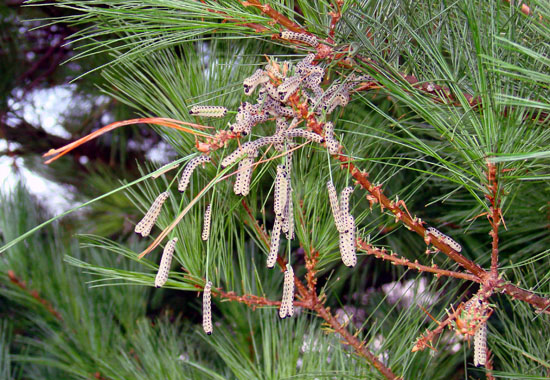Issue 15, August 27, 2010
White Pine Sawfly
White pine sawfly larvae have been reported from Henry County in northwestern Illinois and Champaign County in east central Illinois feeding on white pine. White pine sawfly, Neodiprion pinetum, feeds on both the younger and older needles of white pine, mugo, and red pines, resulting in branches completely stripped of foliage. They typically feed in groups, causing obvious damage to occur quickly. Completely defoliated branches or trees will die, so quick attention is important.

White pine sawfly larvae and damage (A. Hartman).
Larvae are about one inch long when fully grown. The body is yellowish with four rows of black dots down the back and sides. The head is large and black. When fully grown, the larvae drop to the soil where they form cocoons. The larvae round up into prepupae within the brown cocoons, and then pupate in the spring.
White pine sawfly adults emerge later in the spring. They are black and reddish, wasp-like insects with thick waists. The females insert their eggs into pine needles with their saw-like ovipositors, typically laying three to four per needle. Each female repeats that process until there are sixty or more eggs laid per branch. There are two generations per year, with larvae occurring between mid-June and late July and again in mid-August into late September.
Control is relatively easy. Because the larvae feed in a group, they can easily be removed by hand or pruning. Spraying the larvae with acephate (Orthene), azadirachtin (Azatin, Bioneem), carbaryl (Sevin), spinosad (Conserve), or a labeled pyrethroid insecticide will also provide control.--Phil Nixon, Martha Smith, Rick Davis